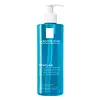La Roche-Posay Effaclar Gel Facial Wash For Oily Skin Versus Clinique All About Clean Liquid Facial Soap
What's inside
What's inside
 Key Ingredients
Key Ingredients

 Benefits
Benefits

 Concerns
Concerns

 Ingredients Side-by-side
Ingredients Side-by-side

Water
Skin ConditioningSodium Laureth Sulfate
CleansingPEG-8
HumectantCoco-Betaine
CleansingHexylene Glycol
EmulsifyingSodium Chloride
MaskingPunica Granatum Pericarp Extract
Skin ConditioningZinc PCA
HumectantPEG-120 Methyl Glucose Dioleate
EmulsifyingSodium Citrate
BufferingSodium Hydroxide
BufferingCaprylyl Glycol
EmollientCitric Acid
BufferingTrisodium Ethylenediamine Disuccinate
Maltodextrin
AbsorbentPentylene Glycol
Skin ConditioningTocopherol
AntioxidantSodium Benzoate
MaskingPhenoxyethanol
PreservativeParfum
MaskingWater, Sodium Laureth Sulfate, PEG-8, Coco-Betaine, Hexylene Glycol, Sodium Chloride, Punica Granatum Pericarp Extract, Zinc PCA, PEG-120 Methyl Glucose Dioleate, Sodium Citrate, Sodium Hydroxide, Caprylyl Glycol, Citric Acid, Trisodium Ethylenediamine Disuccinate, Maltodextrin, Pentylene Glycol, Tocopherol, Sodium Benzoate, Phenoxyethanol, Parfum
Water
Skin ConditioningSodium Laureth Sulfate
CleansingSodium Chloride
MaskingCocamidopropyl Hydroxysultaine
CleansingLauramidopropyl Betaine
CleansingSodium Cocoyl Sarcosinate
CleansingTea-Cocoyl Glutamate
CleansingDi-PPG-2 Myreth-10 Adipate
EmollientAloe Barbadensis Leaf Juice
Skin ConditioningPEG-120 Methyl Glucose Dioleate
EmulsifyingSucrose
HumectantSodium Hyaluronate
HumectantCetyl Triethylmonium Dimethicone PEG-8 Succinate
Butylene Glycol
HumectantHexylene Glycol
EmulsifyingPolyquaternium-7
Laureth-2
CleansingCaprylyl Glycol
EmollientSodium Sulfate
Tocopheryl Acetate
AntioxidantEDTA
Disodium EDTA
Phenoxyethanol
PreservativeWater, Sodium Laureth Sulfate, Sodium Chloride, Cocamidopropyl Hydroxysultaine, Lauramidopropyl Betaine, Sodium Cocoyl Sarcosinate, Tea-Cocoyl Glutamate, Di-PPG-2 Myreth-10 Adipate, Aloe Barbadensis Leaf Juice, PEG-120 Methyl Glucose Dioleate, Sucrose, Sodium Hyaluronate, Cetyl Triethylmonium Dimethicone PEG-8 Succinate, Butylene Glycol, Hexylene Glycol, Polyquaternium-7, Laureth-2, Caprylyl Glycol, Sodium Sulfate, Tocopheryl Acetate, EDTA, Disodium EDTA, Phenoxyethanol
 Reviews
Reviews

Ingredients Explained
These ingredients are found in both products.
Ingredients higher up in an ingredient list are typically present in a larger amount.
Caprylyl Glycol is a humectant and emollient, meaning it attracts and preserves moisture.
It is a common ingredient in many products, especially those designed to hydrate skin. The primary benefits are retaining moisture, skin softening, and promoting a healthy skin barrier.
Though Caprylyl Glycol is an alcohol derived from fatty acids, it is not the kind that can dry out skin.
This ingredient is also used as a preservative to extend the life of products. It has slight antimicrobial properties.
Learn more about Caprylyl GlycolHexylene Glycol is a surfactant. Glycols are a class of alcohols. Hexylene Glycol is a surfactant and emulsifier.
As a surfactant, Hexylene Glycol helps gather dirt and oil on your skin to be washed away.
As an emulsifier, Hexylene Glycol helps keep water and oil together. This prevents them from separating in a product. Hexylene Glycol also thins out the texture of a product by lessening viscosity.
Hexylene Glycol has a small molecular weight.
Learn more about Hexylene GlycolPeg-120 Methyl Glucose Dioleate is used to improve texture and stability of a product. It is sugar based and helps thicken a product.
Once applied, it also creates a thin film to trap moisture in. This helps keep your skin hydrated.
This ingredient is the polyethylene glycol ether of the diester of oleic acid and methylglucose. The 120 represents an average of 120 moles of ethylene oxide.
There is limited research on this ingredient, although it is considered safe to use in skincare products.
Learn more about PEG-120 Methyl Glucose DioleatePhenoxyethanol is a preservative that has germicide, antimicrobial, and aromatic properties. Studies show that phenoxyethanol can prevent microbial growth. By itself, it has a scent that is similar to that of a rose.
It's often used in formulations along with Caprylyl Glycol to preserve the shelf life of products.
Chances are, you eat sodium chloride every day. Sodium Chloride is also known as table salt.
This ingredient has many purposes in skincare: thickener, emulsifier, and exfoliator.
You'll most likely find this ingredient in cleansers where it is used to create a gel-like texture. As an emulsifier, it also prevents ingredients from separating.
There is much debate on whether this ingredient is comedogenic. The short answer - comedogenic ratings don't tell the whole story. Learn more about comegodenic ratings here.
The concensus about this ingredient causing acne seems to be divided. Research is needed to understand if this ingredient does cause acne.
Scrubs may use salt as the primary exfoliating ingredient.
Learn more about Sodium ChlorideSodium Laureth Sulfate (SLES) is a foaming, cleansing, and emulsifying ingredient. It is created from palm kernel oil or coconut oil. SLES is not the same as sodium lauryl sulfate. It is much milder and less likely to irritate.
SLES helps create foam in personal products. It also prevents ingredients from separating, helping to elongate the shelf life.
Sodium Laureth Sulfate is a type of sulfate. It can be drying. We recommend speaking with a professional about using this ingredient if you have concerns.
Learn more about Sodium Laureth SulfateWater. It's the most common cosmetic ingredient of all. You'll usually see it at the top of ingredient lists, meaning that it makes up the largest part of the product.
So why is it so popular? Water most often acts as a solvent - this means that it helps dissolve other ingredients into the formulation.
You'll also recognize water as that liquid we all need to stay alive. If you see this, drink a glass of water. Stay hydrated!
Learn more about Water